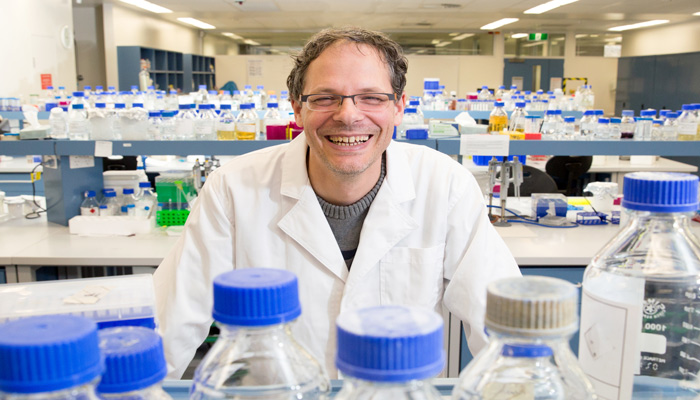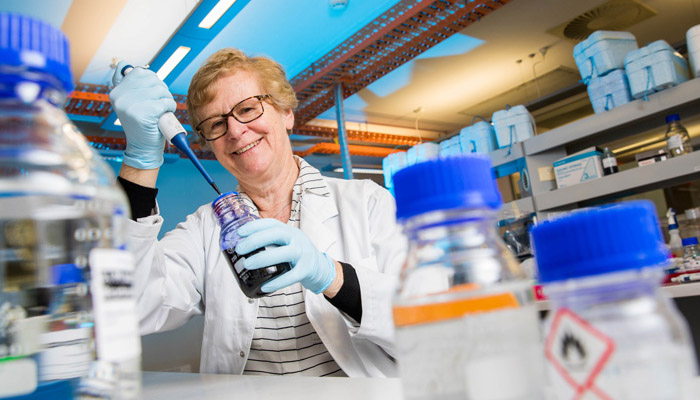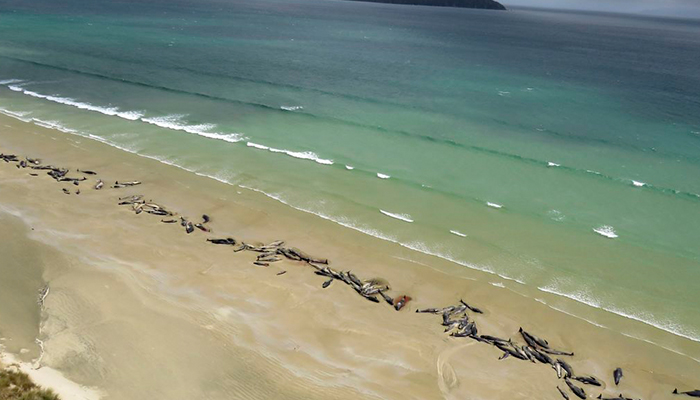Synthetic biology underpins an international market worth $355 billion a year, climbing to $1.1 trillion in five years. The market is in pharmaceuticals, engine fuels, plastics and more, all made using genetically engineered microbes.
Macquarie University’s Distinguished Professor Ian Paulsen wants Australia to have a slice of this high-tech, job-creating, transformational industry. The ability to secure that share starts in laboratories like those at Macquarie’s Genome Assembly Centre. There, Paulsen and his team of 14 scientists work to synthesise microbes that can transform biomass such as agricultural waste into products whose manufacture is presently reliant on fossil-fuel resources.

Economic opportunities: Paulsen says Australia should ideally be part of a $1.1 trillion industry.
It is painstaking, microscopic work in service of a momentous vision: a more sustainable future in which humanity’s dependence on finite and polluting fossil fuels is radically diminished. Paulsen says that, in Australia, that can involve biomanufacturing plants turning plant matter into valuable commodities – sugar cane waste into jet fuel, for instance – creating economic opportunity along the way.
“You could build those facilities in rural areas that currently don’t have the same job opportunities as cities, so that it would increase both rural employment and farm incomes,” says Paulsen.
“Ideally, we should be part of that $1.1 trillion industry, based on the realities that, scientifically we have the talent in Australia to build the microbes, we have one of the world’s best agricultural industries, we have a well-trained workforce and we’re politically stable. And thus we have all the pieces that should route us to develop an advanced biomanufacturing industry based off our highly economically competitive agricultural industry.
“In my opinion, we still have a window of opportunity to be significant players internationally, if we bring it all together and invest in it, but it’s a missed opportunity if we don’t take advantage of it in, say, the next decade.”
A clean, green alternative to cracking crude oil
Internationally, products already being made commercially using synthetic microbes include the anti-malarial drug artemisinin; the sugar substitute stevia; farnasene, a rubber and jet fuel replacement; and isobutanol, a gasoline replacement.

Up and away: Synthetic biology can turn biomass such as crop waste into jet fuel.
At Macquarie, Paulsen heads the Australian component of the international Yeast 2.0 consortium, which is working to create the world’s first synthetic complex organism – a designer, living version of baker’s yeast, which has been an industrial workhorse for millennia.
Among many other ideas and projects, Paulsen, who also heads the university’s Synthetic Biology Consortium, and his team are developing novel biosensors that could be used to improve supply chain processes in fruits and new synthetic compounds that could serve as plastic precursors, food additives and preservatives.
“We’re looking to create the organisms that can do the biochemical transformations as an alternative to getting crude oil out and cracking it in chemical processing plants, with greenhouse gas and toxic chemical byproducts,” Paulsen says.
“We’re not a company, we’re not going to be building production plants, but there could be start-up companies or existing companies that licence the technology from us – we already collaborate with a number of companies on various projects.”
One ‘ah-haa’ moment at a time
Paulsen sees Macquarie’s role as providing the scientific innovation to help drive a dynamic Australian bioproducts industry. He also foresees a next-generation of Macquarie PhD students and early career researchers who not only know the synthetic biology but have the industry exposure to take things even further.
“I’d be hoping they can then launch the start-up companies of the future in this space to drive this forward,” he says.
In the meantime, Paulsen’s passion lies in the fun of discovery, of taking real microbes (it takes a billion of them to become visible to the naked eye as a tiny dot on an agar plate) then adding, subtracting and rearranging genes to get the synthetic version that will achieve the transformation the scientists are seeking.
“In many ways the microbes are smarter than us, so a lot of my work, the fun of it, is trying to work out how the microbes do what they do and how I can modify that to make them do what we want them to do,” he says.
“Sometimes there’s an ‘ah-haa’ moment in a single day, but to bring a project to fruition can take years.”



